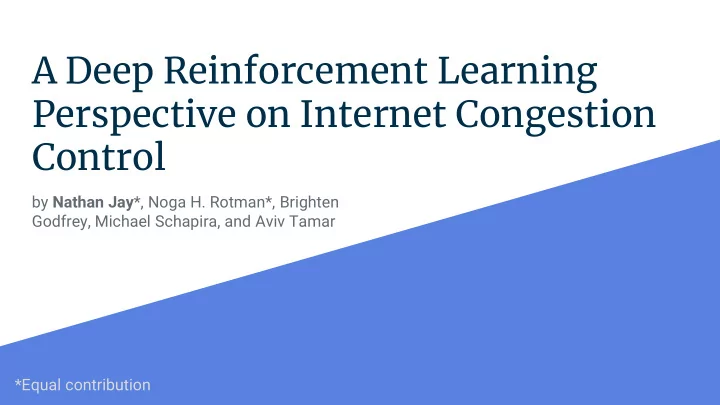

A Deep Reinforcement Learning Perspective on Internet Congestion Control by Nathan Jay *, Noga H. Rotman*, Brighten Godfrey, Michael Schapira, and Aviv Tamar *Equal contribution
Internet Congestion Control The Internet (maybe?) End Host Server
Internet Congestion Control The Internet Data (maybe?) End Host Server t=1
Internet Congestion Control The Internet (maybe?) End Host Server
Internet Congestion Control The Internet Data (maybe?) End Host Server t=5.1
Internet Congestion Control The Internet (maybe?) End Host Server t=5.2 Ack
Internet Congestion Control The Internet (maybe?) End Host Server
Internet Congestion Control The Internet (maybe?) End Host Server t=10.2 Ack
Internet Congestion Control The Internet Data Data (maybe?) End Host Server t=1 t=5.1 t=10.2 t=5.2 Ack Ack
Internet Congestion Control Latency Trace of Internet Path* Latency Latency Time *from pantheon.stanford.edu
Internet Congestion Control Latency Trace of Internet Path* Latency Latency Time *from pantheon.stanford.edu
Internet Congestion Control Latency Trace of Internet Path* Latency Latency Time *from pantheon.stanford.edu
Internet Congestion Control Underlying Complexity: Latency Trace of Internet Path* Enormous, dynamic network ● Latency Latency Massive agent churn ● ~80,000 agents/second Time Very little information ● *from pantheon.stanford.edu
Revisiting Congestion Control Congestion Control Timeline 1988 Flavors of TCP Congestion Control 2016 2019 (Tahoe, Reno, Cubic, Illinois, Vegas, …) ● Same network model ● Same action space Slightly different control algorithms ●
Revisiting Congestion Control Congestion Control Timeline 1988 Flavors of TCP Congestion Control 2016 2019 (Tahoe, Reno, Cubic, Illinois, Vegas, …) ● Same network model ● Same action space Slightly different control algorithms ● Introduction of QUIC , replaces significant amount of Google traffic. New models ● New action space (packet pacing added to Linux) ● ● Novel control algorithms and research (BBR, Copa, PCC)
Reward-based architecture: PCC Observations Performance Statistics Test Monitor Interval Rates Input Features: Network 1. Send Ratio 2. Lat. Ratio 3. Lat. Inflation
Reward-based architecture: PCC Observations Actions Performance Statistics Test Monitor Interval Rates Input Features: Network 1. Send Ratio 2. Lat. Ratio 3. Lat. Inflation
Agent Architecture Monitor Interval Monitor Interval Monitor Interval Monitor Interval Send Rate Rate Change Send Rate Send Rate Utility Factor Utility Input Features: Utility New Rate = 𝛽 > 0: Old Rate x (1 + w 𝛽 ) Throughput Throughput 1. Send Ratio Throughput 𝛽 3-Layer NN Latency 𝛽 < 0: Old Rate / (1 - w 𝛽 ) Latency 2. Lat. Ratio Latency Latency Inflation Latency Inflation 3. Lat. Latency Inflation Loss Rate Loss Rate Inflation Loss Rate History Length
Agent Architecture Monitor Interval Monitor Interval Monitor Interval Monitor Interval Send Rate Rate Change Send Rate Send Rate Utility Factor Utility Input Features: Utility New Rate = 𝛽 > 0: Old Rate x (1 + w 𝛽 ) Throughput Throughput 1. Send Ratio Throughput 𝛽 3-Layer NN Latency 𝛽 < 0: Old Rate / (1 - w 𝛽 ) Latency 2. Lat. Ratio Latency Latency Inflation Latency Inflation 3. Lat. Latency Inflation Loss Rate Loss Rate Inflation Loss Rate History Length Key Design Choice: Scale-free observations affect robustness
Training/Testing Environment Training Environment: Simulated network ● ● Each episode chooses link parameters from a range: Capacity Latency Loss Queue 1 - 6mbps 50 - 0 - 5% 1 - ~3000pkt 500ms Standard gym at ● github.com/PCCProject/PCC-RL
Training/Testing Environment Training Environment: Testing Environment: Simulated network Real packets in Linux kernel ● ● ● Each episode chooses link network emulation parameters from a range: Much wider testing range: ● Capacity Latency Loss Queue Capacity Latency Loss Queue 1 - 6mbps 50 - 0 - 5% 1 - ~3000pkt 1 - 128mbps 1 - 0 - 20% 1 - 10000pkt 500ms 512ms Standard gym at ● github.com/PCCProject/PCC-RL
State-of-the-art Results Emulated Dynamic Link Performance Test Description: Emulated network, with real ● Linux kernel noise Time-varying link ●
State-of-the-art Results Emulated Dynamic Link Performance Test Description: Emulated network, with real ● Linux kernel noise Time-varying link ●
State-of-the-art Results Emulated Dynamic Link Performance Test Description: Emulated network, with real ● Linux kernel noise Time-varying link ●
State-of-the-art Results Emulated Dynamic Link Performance Test Description: Emulated network, with real ● Linux kernel noise Time-varying link ●
State-of-the-art Results Emulated Dynamic Link Performance Test Description: Emulated network, with real ● Linux kernel noise Time-varying link ● Aurora is on the Pareto front of state-of-the-art algorithms
Exciting Directions Multi-agent scenarios: ● Cooperative ○ ○ Selfish Online training: ● Few-shot training ○ Meta-learning ○ Multi-objective Learning: ● File transfer ○ ○ Live video By The Opte Project - Originally from the English Wikipedia; description page is/was here., CC BY 2.5, https://commons.wikimedia.org/w/index.php?curid=1538544
See us at: Poster #45 6:30pm - 9:00pm Pacific Ballroom Code available at github.com/PCCProject/PCC-RL
Recommend
More recommend